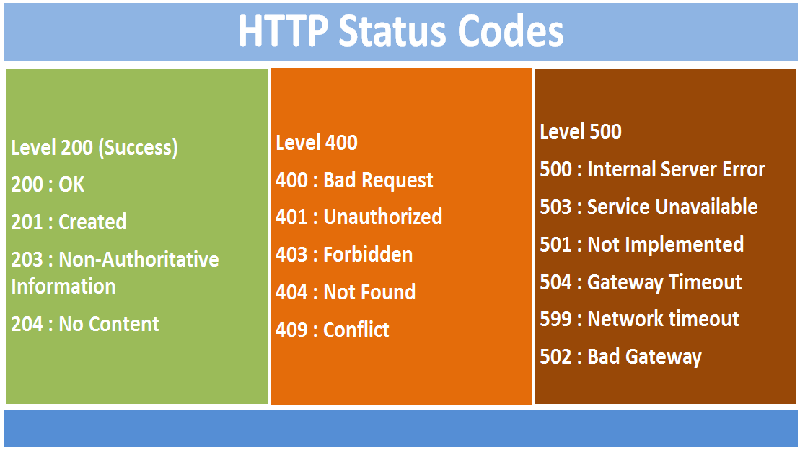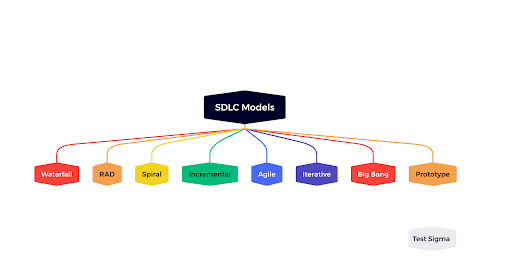
HTTP Response is the packet of information sent by Server to the Client in response to an earlier Request made by Client. HTTP Response contains the information requested by the Client. For example, the request to Weather Web Service made in the HTTP Request tutorial will contain the weather details of the location.
Error Codes
The error code is a special message according to the status of particular software applications. It is mainly used to find out the errors occurring in hardware, software or any type of wrong inputs. Error codes are utilized in different techniques for tacking improper issues. They are commonly like special cases taking care of in programming languages that help it.
Nowadays error codes are gradually disappearing from the developer’s condition as present-day object-situated programming dialects replace them with exceptions. The benefit of being taken care of with express squares of code, separate from whatever is left of the code. While it is viewed as poor practice in techniques that utilization error codes and return codes to show disappointment, software engineers generally neglect to check return values for mistake conditions.
That carelessness can make so impacts, which later causes some problems. Special cases are executed to separate to deal with code from whatever remains of the code. Making the error separated by dealing with code from the typical logic makes programs simpler to compose and comprehend since one square of mistake taking care of code can support the errors from any number of capacity calls.
And taking care of it in an additional way makes the code more clear with readability than usage with codes having an error since special case taking care of does not makes the stream disturbed. They provide the code with continuous checks for conditions with errors.
The World Wide Web sets a good setup for data. In response to a client request to the server, the status codes are issued by a server. The codes consist of from IETF with some specifications provided and consisting of main applications of HTTP!.
Every response of HTTP response status codes is dispersed into classes of five categories. The definition of the status code for the first digit is the response in class. Whereas the code of the last one will not have any categorization or any of the classes like the first digit.
Here are the main 5 values that should get set for the first digit.
Informational- 1xx
This is for the request will continue its process after receiving it. They provide the information which indicates that the requested request was received and properly understood. This has been issued during the time of provisional basis while the rest process will be done after the process got continuous.
They set an alert for the final response of the call. The message contains just of the status line and optional header fields and is ended by a vacant line. As the HTTP/1.0 standard did not characterize any 1xx status codes, servers must not send a 1xx reaction to an HTTP/1.0 agreeable customer except under trial conditions.
100 Continue
Sending a vast requested body to a server after a request has been rejected for poor headers would be wasteful. If the server has gotten the request headers and the customer ought to continue to send the body which requested. To have a server check the request’s headers, a customer must send 100 Continue as a header in its underlying solicitation and get a 100 Continue status code accordingly before sending the body.
On the off chance that the customer gets an error code, for example, 403 (Forbidden) or 405 (Method Not Allowed) at that point it shouldn’t send the request body. The response 417 Expectation Failed shows that the request ought to be repeated without the Expect header as it explains that the server doesn’t support desires.
101 Switching Protocols
The requester has requested that the server switch protocols and the server has consented to do so.
102 Processing
A WebDAV request may contain many sub-requests including record tasks, requiring quite a while to finish the request. This code shows that the server has received and is preparing the request, yet no reaction is accessible yet. This will keep the customer from timing out and accepting the request was lost.
103 Early Hints
Used to restore some reaction headers before a conclusive HTTP message.
Successful- 2xx
If the request which has been given is successfully received, accepted and understood.
200 OK
The standard reaction for effective HTTP asks. The real reaction will rely upon the request strategy utilized. In a GET request, the reaction will contain a substance relating to the asked for the asset.In a POST request for, the reaction will contain an element describing or containing the aftereffect of the action.
201 Created
The request has been satisfied, bringing about the production of another resource.
202 Accepted
The request for has been recognized for handling, however, the preparing has not been finished. The request for might or probably won’t be necessarily followed up on and might be refused when handling occurs.
203 Non-Authoritative Information
The server is a changing intermediary that got a 200 OK from its cause, however, is restoring an altered rendition of the root’s response.
Eg: a Web quickening agent.
204 No Content
The server completely handled the request and isn’t restoring any content.
205 Reset Content
The server effectively prepared the request, however, it isn’t restoring any substance. In contrast to a 204 reaction, this reaction necessitates that the requester reset the record view.
206 Partial Content
The server will provide with just a piece of the asset because of a range header sent by the customer. The range header is utilized by HTTP customers to allow the continuing of interfered with downloads or split a download into different concurrent streams.
207 Multi-Status
The message body that pursues is, of course, an XML message and can contain various separate reaction codes, contingent upon what number of sub-demands was made.
208 Already Reported
The individuals from a DAV restricting have just been specified in a previous piece of the (multistate) reaction, and are not being incorporated once more.
226 IM Used
The server has completed the request for the asset, and the reaction is a portrayal of the aftereffect of at least one example controls related to the current instance.
Redirection- 3xx
To complete the request, there are further ideas and actions needed to take. This class of status code shows the customer must make an extra move to finish the request.
A considerable lot of these status codes are utilized in URL redirection. A client operator may do the extra activity with no client cooperation just if the approach utilized in the second request is GET or HEAD. A client operator may naturally divert a request. A client operator ought to recognize and intercede to avert patterned redirects.
300 Multiple Choices
Shows different choices for the asset from which the customer may pick (using specialist driven substance exchange). For instance, this code could be used to display various video position options, to list documents with various filename developments, or to recommend word-sense disambiguation.
301 Moved Permanently
This and every single future request ought to be coordinated to the given URL.
302 Found
Advises the customer to take a view at another URL.302 has been supplanted by 303 and 307. This is a case of industry work on negating the standard. The HTTP/1.0 particular required the customer to play out a transitory divert, however, prominent programs executed 302 with the usefulness of a 303 See Other.
Along these lines, HTTP/1.1 included status codes 303 and 307 to identify the two behaviors. However, some Web applications and structures use the 302 status code as though it were the 303
303 See Other
It can be found under another URL even after requesting b using the GET strategy. At the point when gotten because of a POST (or PUT/DELETE), the customer ought to think that the server has gotten the information and should issue another GET request for the given URL.
304 Not Modified
Shows that the asset has not been changed since the variant discovered by the request headers If-Modified-Since or If-None-Match. In such a case, there is no compelling reason to retransmit the asset since the customer still has a formerly downloaded copy.
305 Use Proxy
The asked for the asset is accessible just through an intermediary, the location for which is given in the reaction. Numerous HTTP customers, (for example, Mozilla Firefox and Internet Explorer) don’t effectively deal with reactions with this status code, fundamentally for security reasons.
306 Switch Proxy
Never again utilized. Initially signified “Ensuing solicitations should utilize the predefined proxy.
307 Temporary Redirect
The request ought to be rehashed with another URL; be that as it may, future solicitations should, in any case, utilize the first URL. Rather than how 302 was generally executed, the requesting technique isn’t permitted to be changed while reissuing the first request.
For instance, a POST asks for ought to be continued utilizing another POST request.
308 Permanent Redirect
Every single future request ought to be continued utilizing another URL. 307 and 308 parallel the practices of 302 and 301, however, don’t enable the HTTP technique to change.
In this way, for instance, presenting a structure to a for all time diverted assets may move very smoothly.
Client Error- 4xx
It is shown for the request which cannot be accomplished and it may contain bad syntax. This class of status code is planned for situations in which the mistake appears to have been brought about by the customer. But when reacting to a HEAD request for, the server ought to incorporate a substance containing an explanation of the error circumstance, and whether it is a transitory approximately changeless condition.
These status codes are relevant to any demand strategy. Client specialists should show any included element to the user.
400 Bad Request
The process cannot set the demand because of a clear customer error
401 Unauthorized
Yet explicitly for use when validation is required and has fizzled or has not yet been given like 403 Forbidden. The reaction must incorporate a WWW-Authenticate header field containing a test relevant to the asked for the asset. See Basic access validation and Digest gets to authentication.
401 semantically signify “unauthenticated”, for example, the client does not have the required certifications.
402 Payment Required
The first goal was that this code may be utilized as a component of some type of computerized money or micropayment plot, as suggested for instance by GNU Taler, yet that has not yet occurred, and this code isn’t typically utilized. Google Developers API utilizes this status if a specific designer has surpassed the day by day limit on requests. This code is utilized by Sipgate if a record does not have adequate assets to begin a call.
403 Forbidden
It was true for a requested request, however, the server is rejecting activity. The client probably won’t have the important consents for an asset or may require a record or something to that effect.
404 Not Found
The requested for an asset couldn’t be found however might be available later on. Resulting requests for by the customer are allowable.
405 Method Not Allowed
A request for strategy isn’t bolstered for the asked for an asset; for instance, a GET asked for on a structure that expects information to be exhibited using POST, or a PUT request for on a read-just asset.
406 Not Acceptable
The requested for an asset is equipped for creating just substance not worthy as per the Accept headers sent in the request. See Content exchange.
407 Proxy Authentication Required
The customer should initially verify itself with the proxy.
408 Request Timeout
The server coordinated out hanging tight for the demand. As indicated by HTTP details: “The customer did not deliver a demand inside the time that the server was set up to pause. The customer MAY rehash the demand without changes at any later time.”
409 Conflict
Shows that the demand couldn’t be prepared as a result of contention in the present condition of the asset,
Eg: an alter struggle between different synchronous updates.
410 Gone
Demonstrates that asked by asset is never again accessible and won’t be accessible again. This ought to be utilized when an asset has been deliberately expelled and the asset ought to be cleansed. After getting a 410 status code, the customer ought not to request for the asset later on.
Customers, for example, web search tools should expel the asset from their indices. Most use cases don’t require customers and web crawlers to cleanse the asset, and a “404 Not Found” might be utilized.
411 Length Required
It did not indicate the length of its substance, which is required by the asked for the resource.
412 Precondition Failed
One of the conditions which won’t primarily meet by the server that the request is done by the requester.
413 Payload Too Large
As they have requested for a bigger than the server is eager or ready to process. Recently called “Demand Entity Too Large”.
414 URL Too Long
Frequently the consequence of an excessive amount of information being encoded as a question string of a GET need for, in which case it ought to be changed over to a POST request called Requested for URL Too Long earlier. Since the URL gave was excessively long to the server to process.
415 Unsupported Media Type
There is a media type for the element which is requested by the server or asset does not bolster.
416 Range Not Satisfiable
The customer has requested a portion of the record, however, the server can’t supply that divide. For instance, if the customer requested a piece of the record that lies past the finish of the file called Request for Range Not Satisfiable previously.
417 Expectation Failed
The server can’t meet the prerequisites of the Expect request for the header field.
418 I’m a tea kettle
This code was set in 1998 as one of the conventional IETF April Fools’ jokes, Hyper Text Coffee Pot Control Protocol, and isn’t required to be actualized by real HTTP servers. The RFC determines this code ought to be returned by tea kettles asked for to mix coffee.
This HTTP status is utilized as an Easter egg in a few sites, including Google.com.
421 Misdirected Request
At a server, the element has been requested`1’ that can’t deliver a response.
422 Unprocessable
Entity As per the request, they are not able to be pursued because of semantic errors.
423 Locked
The asset that is being gotten to is locked.
424 Failed Dependency
The request for fizzled because it relied upon another demand and that ask for fizzled
e.g.a PROPPATCH
426 Upgrade Required
The customer should change to an alternate convention.
428 Precondition Required
The origin point server requires the demand to be restrictive. Proposed to keep the ‘lost refresh’ issue, where a customer GETs an asset’s state, modifies it, and PUTs it back to the server.When in the meantime an outsider has adjusted the state on the server, prompting a conflict.
429 Too Many Requests
The client has sent such a large number of solicitations in a given measure of time. Expected for use with rate-restricting schemes.
431 Request Header Fields Too Large
The server is reluctant to process the demand because either an individual header field or all the header fields, on the whole, are too large.
451 Unavailable For Legal Reasons
A server administrator has gotten a lawful interest to deny access to an asset or to a lot of assets that incorporates the asked for asset
Server Error- 5xx
It is giving out the notification that the server fails to fulfill a valid request. Reaction status codes starting with the digit “5” demonstrate cases in which the server knows that it has encountered an error or are generally unequipped for playing out the demand. But when reacting to a HEAD request for, the server ought to incorporate an element containing a clarification of the mistake circumstance and show whether it is an impermanent or unchanging condition.
Similarly, client operators or user agents should show any included element to the client. These reaction codes are appropriate for any method that is requested.
500 Internal Server Error
A common error message, given when a condition at the starting period was experienced and not any more explicit message is suitable.
501 Not Implemented
The server either does not make aware of the demanding technique, or it comes up short on the capacity to satisfy the demand. Generally, this indicates the future accessibility
Eg: another element of a web-administration API
502 Bad Gateway
The server was going about as an intermediary and got a reaction that is invalid from the upstream server.
503 Service Unavailable
The server is right now inaccessible. By and large, this is a brief state.
504 Gateway Timeout
The server was going about as a door or intermediary and did not get a promising reaction from the upstream server.
505 HTTP Version Not Supported
The server does not bolster the HTTP convention rendition utilized in the request.
506 Variant Also Negotiates
The Straightforward substance is the arrangement for the demanding results in a roundabout reference.
507 Insufficient Storage
The server can’t store the portrayal expected to finish the request.
508 Loop Detected
The server recognized an infinite circle while preparing the demand.
510 Not Extended
Further developments to the demand are required for the server to satisfy it.
511 Network Authentication Required
The customer needs to validate to pick up the system get to. Planned for use by capturing intermediaries used to control access to the system



